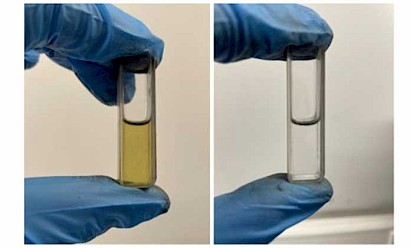Waverly Carbon cleaning up tire char for better rCB
Waverly Carbon has invested in state-of-the-art laboratory and processing facilities. The company carefully analyses all potential feedstock for consistency and level of volatiles in order to apply the correct processing. Waverly Carbon works collaboratively with raw material partners to ensure feedstock is high quality and consistent, to ensure they create rCB grades that are fit for purpose for the rubber, plastics, and coatings sectors.
 When a tire is recycled through tire pyrolysis, the solid material that remains from the pyrolysis of the rubber, commonly referred to as tire char or raw rCB, is composed of carbon black and varying amounts of impurities, such as silica, zinc, and sulphur. The latter are found in the original tire as additives to the production process.
When a tire is recycled through tire pyrolysis, the solid material that remains from the pyrolysis of the rubber, commonly referred to as tire char or raw rCB, is composed of carbon black and varying amounts of impurities, such as silica, zinc, and sulphur. The latter are found in the original tire as additives to the production process.
These impurities are collectively referred to as ‘Ash’ and can vary from 15-25% of the content by weight of the char. The level of ash content directly effects the beneficial properties of the rCB and is a direct consequence of the choice of tire stock. Tires with lower ash content will produce a higher strength rCB.
Good feedstock choice also needs to be matched by a consistent and balanced pyrolysis process, as a poor and variable pyrolysis process can equally affect the quality of the char used in the production of rCB; not by influencing the ash content but by only partially removing the volatiles or ‘oily residue’ from the char. This occurs when a pyrolyser is not run at a high enough temperature or residence time of the rubber in the pyrolysis reactor is too short.
This ‘dirty’ char can have a strong odour, offer weak reinforcing properties, and cause problems in further processing steps that are required to turn it into rCB. To produce an rCB suitable for the rubber, plastics, and coatings sectors, char needs to be clean, consistent, and free of oily residue. Only then can it be used to create a dependable and quality rCB, for a wide range of applications.
To effectively convert tire char into a consistent, quality rCB that can be used across the plastics, rubber, and coatings industries, char must be clean. ‘Clean’ in rCB parlance means relatively free from oily volatiles and general contamination, such as metals and other physical bodies.
The cleanliness can be measured in several ways, but our preferred method and the industry standard test is the Transmittance of Toluene Extract test, which provides a guide to the level of volatiles present on the char.
When char is mixed with toluene, volatiles are extracted from the char. A heavy presence causes the mixture to turn brown, whilst a clear solution indicates the absence of significant levels of volatiles, implying that the material can be processed well.
A spectrophotometer is used to provide a clear percentage value of the level of volatility in the solution. The higher the percentage, the higher the level of cleanliness of the char.
You can return to the main Market News page, or press the Back button on your browser.

